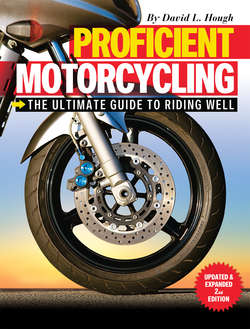Читать книгу Proficient Motorcycling - David L. Hough - Страница 59
На сайте Литреса книга снята с продажи.
Ergonomics
ОглавлениеIf you’ve been ho-hum about the subject of ergonomics (how the rider fits on the motorcycle), consider that how you sit on the bike and reach toward the grips has a lot do with steering control. You’ll have better control of the bike when you can reach the grips in a natural position, with your arms slightly bent and your feet braced under your body weight, not forward. So if you find your motorcycle difficult to control, take a close look at the ergonomics. It’s not just an I thing.
If you ride a cruiser-style machine with the foot pegs or boards mounted far forward, you’ll find it somewhat more difficult to steer accurately because you can’t use your legs to brace against your steering input. Since the feet-forward seating position means you will normally be pulling on both grips to counteract wind pressure, you’ll need to modify your countersteering technique. Rather than press on the grip on the turn side, pull on the opposite grip. That is, approaching a left turn, pull on the right grip.
The feet-forward seating position also makes it difficult to support your weight on your feet. For tight turns, you can simply slide your butt toward the edge of the saddle. For instance, when making a tight U-turn to the left, you can slide over to the right edge of the saddle.
Cruisers with forward-mounted footboards require slightly different steering techniques.
I’ve got a warm-up exercise for you to practice tight turns. It’s just a long figure 8 about eighteen feet wide and forty feet long. Enter at one corner, make a tight turn at the other end, reverse direction, make another tight turn, and continue out the far end.
If tight turns make you nervous, this is just what you need to practice. Shift your weight to the outside, push both grips in the direction you want to go, and keep the engine pulling. Slip the clutch as needed, but don’t pull the clutch and try to coast. Most motorcycles can turn a figure 8 within the eighteen-foot by forty-foot area. If you can’t turn within the eighteen-foot width, move the cones out to twenty or twenty-five feet at first, then pull the cones in as you gain skill and confidence. If your bike has independent front/rear brakes, try easing on a little rear brake to give the engine something to pull against.
The figure-8 box is an exercise to help you practice tight U-turns. Enter at one corner, make a U-turn at the other end, make another U-turn at the near end, and exit at the far corner. Keep the engine pulling, even if you have to slip the clutch.
If you don’t have time to lay out the figure-8 exercise, try making a figure 8 before you park the bike at the end of a ride, or practice a few figure 8s as you arrive in the company parking lot each morning. Anyone can ride straight because the bike is doing most of the balancing. It’s in the tight turns where we find out who can ride and who is just going along for the ride.
